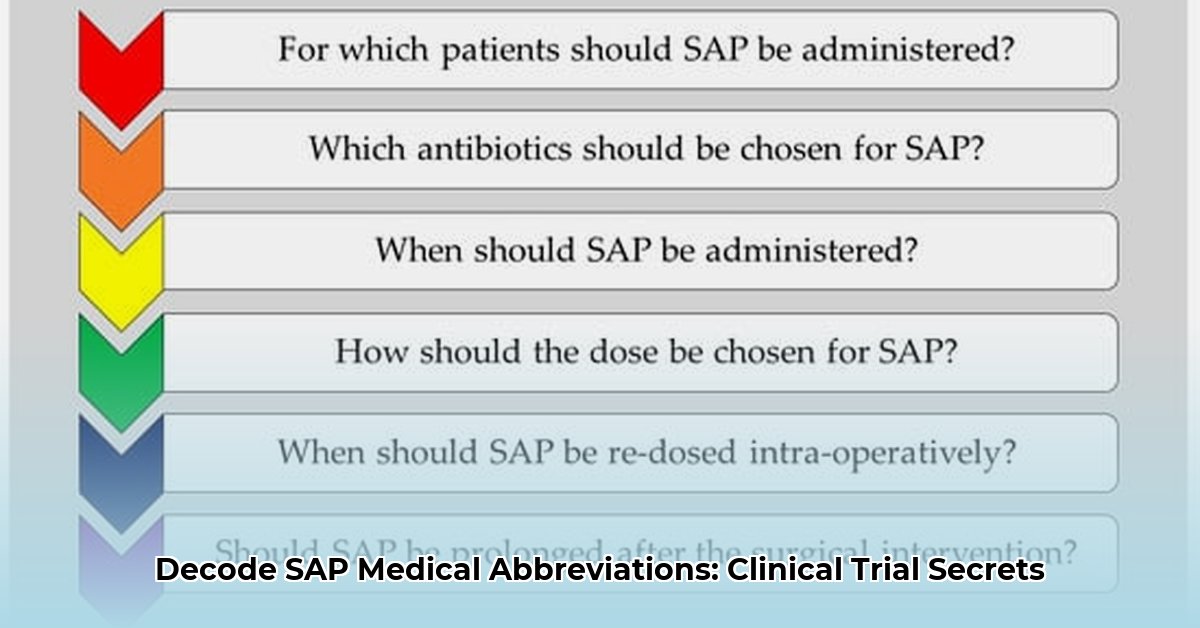
This guide provides a step-by-step approach to creating and implementing effective Statistical Analysis Plans (SAPs) for clinical trials. An SAP acts as a roadmap, ensuring the reliability and trustworthiness of your data analysis, ultimately strengthening the credibility of your research findings. Understanding and employing best practices in SAP development are essential for conducting high-quality clinical trials.
Understanding SAPs: Your Clinical Trial Roadmap
A Statistical Analysis Plan (SAP) is a detailed, pre-planned document outlining how you will analyze the data collected during a clinical trial. It's crucial because it ensures your analysis is objective, reproducible, and aligned with your study's objectives. Failing to use a well-defined SAP increases the risk of bias and reduces the credibility of your results. Think of it as the blueprint for your data analysis – you wouldn't build a house without plans, would you?
The Importance of a Well-Defined SAP
Why is a well-defined SAP so essential? Several key reasons highlight its importance:
- Objective Analysis: A pre-defined SAP prevents post-hoc analysis (analyzing data after seeing the results), a major source of bias. It ensures objectivity and maintains the integrity of your findings.
- Transparency and Reproducibility: A detailed SAP enhances transparency, allowing other researchers to understand and replicate your analysis, fostering trust and contributing to scientific advancement.
- Efficiency: A clear plan streamlines the analysis process, reducing errors and wasted time and resources.
- Regulatory Compliance: Many regulatory agencies require a well-documented SAP as part of the clinical trial submission process.
Key Components of a Robust SAP
A robust SAP includes several critical elements:
Study Objectives and Hypotheses: Clearly defined primary and secondary objectives and corresponding hypotheses guide the entire analysis. These should be specific, measurable, achievable, relevant, and time-bound (SMART). For instance, "To demonstrate a statistically significant reduction in systolic blood pressure in patients treated with Drug X compared to placebo."
Data Description: This section details the types of data to be collected (continuous, categorical, etc.), how it will be handled (including cleaning procedures), and how it will be stored and managed. Addressing the inevitable issue of handling missing data is especially critical.
Statistical Methods: The selection and justification of appropriate statistical methods are paramount. This includes specifying tests (t-tests, ANOVA, regression, etc.), significance levels (alpha), and any adjustments for multiple comparisons. Why were these specific methods chosen? Justify your selection clearly.
Analysis Population: Clearly define the population that will be included in the analysis (e.g., intention-to-treat, per-protocol). These definitions should be unambiguous.
Interim and Final Analyses: Specify whether interim analyses are planned and define the criteria for stopping the trial early.
Tables and Figures: The SAP should outline the tables and figures planned for the final report. This ensures consistent and transparent reporting.
Software Specification: Identify the statistical software to be used (SAS, R, SPSS, etc.) to aid in reproducibility.
Building Your SAP: A Step-by-Step Guide
Creating a comprehensive SAP involves a structured approach. Follow these steps to build a robust and effective plan:
Define Study Objectives and Hypotheses (SMART): Begin by clearly outlining your hypotheses and objectives. What is your primary goal? What do you expect to find?
Describe the Data: Detail the types of data to be collected, how the data will be formatted, and methods for handling missingness (e.g., imputation, deletion).
Select Statistical Methods: Choose the appropriate statistical methods based on your study design and data type. Justify each choice.
Define the Analysis Population: Specify the population for the primary and secondary analyses (intention-to-treat, per-protocol, etc.).
Plan for Missing Data: Outline a strategy to account for missing data. Transparency here is key.
Specify Statistical Tests and Significance Levels: Detail the specific statistical tests that will be used, including the significance level and any adjustments for multiple comparisons.
Outline Tables and Figures: Plan the tables and figures that will be included in the final report.
Specify the Software: Note the statistical software package(s) that will be used.
Review and Approval: Before initiating the trial, obtain review and approval from relevant stakeholders (statisticians, investigators, sponsor).
Potential Pitfalls and Mitigation Strategies
While following a structured approach minimizes risks, potential challenges remain. Proactive consideration of these challenges can enhance the robustness of your SAP.
| Potential Problem | Mitigation Strategy |
|---|---|
| Inconsistent SAP application | Standardized templates, rigorous training, quality checks |
| Lack of clarity in the SAP | Thorough explanation of statistical methods and justifications |
| Software compatibility issues | Extensive testing and validation of software choices |
| Problems with data quality | Data cleaning procedures, validation checks |
| Regulatory non-compliance | Strict adherence to relevant guidelines |
| Bias in analysis | Pre-specified analysis plan, adherence to protocol |
Conclusion: SAPs – The Cornerstone of Reliable Clinical Trials
Developing a well-defined SAP is crucial for conducting high-quality clinical trials. By carefully following these steps and addressing potential challenges, you'll significantly enhance the reliability, transparency, and reproducibility of your research. Remember, a strong SAP is not just a document; it's a commitment to rigorous and ethical research practices.